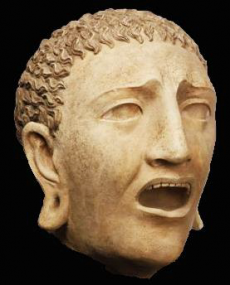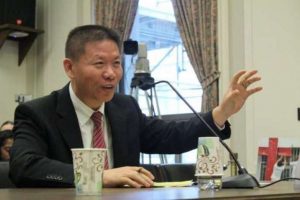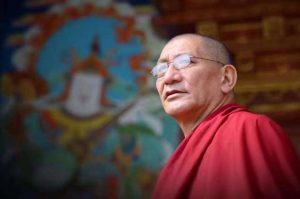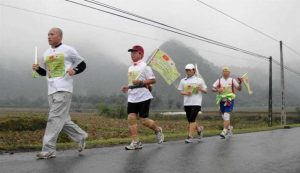
Note from the author: Ryokyo Takagi, the chief abbot of Seiganto-ji and chairman of the Saigoku Kannon Pilgrimage Association, died on 4 July at the age of 82, while this article was being prepared. His burial took place on 8 July at Seiganto-ji. Mourning him was Ryoei Takagi, his younger brother and deputy chief abbot of Seiganto-ji. After the observance of the traditional 49-day period of mourning, a successor for the position of chief abbot and chairman of the association will be decided.
Kumano Shugen, a Shugendo group based at Nachi Falls in the Kumano area of Japan, celebrated the 33rd anniversary of their revival in 2020. The leader of the group, a monk, Ryoei Takagi, from the temple Nachi-san Seiganto-ji, followers of the group, and members of the local community, have dedicated their time and energy to this renewal effort.
To commemorate the occasion, the Kumano Shugen photobook was published. Local photographer Takeshi Mori had been allowed to follow the Kumano Shugen adherents during their arduous ascetic training in the mountains with his camera, thus creating a unique visual document over a period of 20 years.
This article is based on interviews published in this photobook and on conversations with the monk and the photographer. I would like to thank Ryoei Takagi and Takeshi Mori for allowing me to retell the revival story here, as well as for the permission to use Mori’s photos.

A fresh start by chance
Shugendo activities had all but disappeared in the Kumano area after 1872, when the Shugendo Abolition Order was issued by the Japanese government. It was more than 100 years later, in 1988, that revival efforts began, almost by chance.
While sorting through the belongings of his late father, who had passed away the year before, Ryoei Takagi found a set of the characteristic yamabushi clothing and implements in a wooden chest. His father, Ryoko Takagi, had been the seventh chief abbot of Nachi-san Seiganto-ji (青岸渡寺; Temple of Crossing the Blue Shores) for 60 years. After his passing, his oldest son, Ryokyo, became the new chief abbot and his second son, Ryoei, the deputy chief abbot.
Ryoei considered it a kind of memorial service to his late father to try to restore the Shugendo heritage of this region. So he took on the mammoth task of leading a comeback of the ascetic mountain monastic tradition in Kumano, which he named Kumano Shugen. This became his life’s mission and passion.

Situating Kumano and the Kumano faith
A network of pilgrimage trails, now called the Kumano Kodo (Old Road to Kumano), runs across the mountainous and forested Kii Peninsula, south of Osaka City. These trails connect three spiritual centers: Kumano Sanzan in the south, the Shingon Buddhist mountain monastery of Koyasan in the north, and the Shugendo center of Yoshinoyama, also in the north of the peninsula.
Over centuries, pilgrims were attracted by the Kumano faith, a spiritual tradition that reveres the Kumano Sanzan (熊野三山), the three sacred mountains of Kumano. These places of ancient nature worship became associated with kami, Shinto deities that were later merged with Buddhist deities and venerated as Kumano Gongen (熊野権現). Gongen (avatar, incarnation) are the manifestation of a buddha in the form of indigenous deities.
This syncretism of Shintoism and Buddhism, referred to as Shinbutsu-shugo, prevailed over the centuries until the beginning of the Meiji period in 1868, when the two religions were forcefully split by the enactment of the Shinbutsu-Bunri separation laws. Presently, the Kumano Sanzan are synonym with the Three Grand Shrines of Kumano, located respectively in Hongu Town, Shingu City, and in Nachi Town.
At Nachi, the once syncretic shrine-temple compound is now divided into the Nachi Taisha shrine on the one hand and the temple Seiganto-ji on the other. They are still located beside each other but no longer connected. Still, visitors can gain an impression of the syncretism that still prevails in the Kumano area.
What is now Seiganto-ji was previously known as Nyoirinkannon-do (如意輪 観 音 堂), a hall of worship dedicated to Nyoirin Kannon.

Seiganto-ji’s ancient history
The founder of the first Kannon Hall at Nachi is said to be Ragyo, an Indian monk, later declared a saint (Shonin), who supposedly lived in the fifth century. He is said to have traveled the Nachi River upstream from the Pacific Ocean until he found the Nachi-no-Otaki, the Big Nachi Falls, which gushes 133 meters down a single drop over the sharp edge of a cliff.
During Ragyo’s severe ascetic training under this waterfall, Kannon, the Goddess of Mercy, appeared to him and thereafter he set up a hermitage to worship this bodhisattva. The Buddhist deity associated with the kami worshipped at the Nachi Falls thus became Kannon.
In the late sixth to early seventh centuries, another monk, later declared a saint, named Shobutsu came to Nachi for ascetic training. He is said to have come from Yamato, the newly formed first Japanese nation-state in the north of the Kii Peninsula. He underwent ascetic training at Nachi Falls and carved a statue of Nyoirin Kannon, which he enshrined in a larger temple hall.
In the eighth century, the founder of Shugendo, En no Gyoja, is said to have traversed the mountain range that connects Yoshinoyama with the Kumano area. He is credited with having “opened” this trail, called the Okugakemichi, which became a Yamabushi ascetic training trail.

Kannon worship at Nachi
The Nyoirin Kannon at Nachi became the focus of a Kannon “cult.” Seiganto-ji was the first temple on a pilgrimage circuit dedicated to Kannon. This pilgrimage circuit, which is still popular today, connects 33 temples in the Kansai area of Japan.
This dedication was made by Emperor Kazan in the 10th century after he completed 1,000 days of ascetic training by the Nachi waterfall. He is also said to have mapped out the whole pilgrimage circuit, with the help of another monk, and wrote the Goeka (sacred poetic hymns), which are still chanted at the 33 temples today.
The main temple hall was burned down by troops of the warlord Oda Nobunaga during the civil wars of the 16th century, and was rebuilt soon after in 1590 by order of another Japanese warlord, Toyotomi Hideyoshi. Reconstructed again in 1924, it is the same wooden temple hall that we can admire today. The main deity worshipped at Seiganto-ji is the four-meter statue of Nyoirin Kannon, carved by Shobutsu Shonin from a single piece of wood from a camellia tree.

Honoring the legacy of the ancestors
For more than 1,200 years, Shugenja (followers of Shugendo) practiced in the forest and mountains of Kumano, an area that is considered the spiritual heartland of Japan. These Shugenja became pilgrimage leaders to retired emperors, aristocrats, warlords, and others who could afford their services.
As belief in the Kumano faith began to thrive, the worship of Kumano deities spread across the Japanese archipelago, thanks to the activities of Shugenja and their Sendatsu leaders. They traveled across the country to propagate the faith, soliciting donations in support of the Kumano Sanzan and recruiting pilgrims who would undertake this arduous journey in the hope of healing and salvation.
Supporters of the Kumano faith set up Kumano shrines in many places; there are still more than 3,000 Kumano shrines across Japan.
Ryoei Takagi strongly believes that it is thanks to the efforts of these Shugenja that the Kumano faith remains popular and attracts many pilgrims to Kumano, even today. He wants to honor them and follow in their footsteps by carrying the Kumano faith into the future.

Rebuilding the temple grounds
Honoring this 1,500-year history of ascetic training at the Nachi Falls and of the worship of Kannon Bodhisattva, Ryoei’s father took it upon himself to reconstruct temple buildings that were destroyed by the anti-Buddhist movement.
At the end of the 19th century, when the Shugendo abolition order was issued, there were three large temple halls, including the Kannon Hall, and 37 other buildings used for residential and training purposes. Of these, only the Nyoirin Kannon Hall and the abbot’s quarters remained.
Ryoko had moved from Nagoya City to the small village of Nachi, where he spent many years on this reconstruction work. This included rebuilding the now-famous and much-photographed three-story pagoda, as well as the beginning of the recovery and maintenance of the pilgrimage trails.

Community support
Ryoko’s son Ryoei continued with the recovery of trails, especially the southern part of the Okugakemichi, the Yamabushi ascetic training trail that connects the Shugendo center of Yoshino with the Kumano Sanzan over a distance of 100 kilometers.
Followers of Shugendo are required to walk the Okugakemichi for training as often as possible, and members of Kumano Shugen have walked this trail every year since their revival.
Most parts of the trail follow mountain ridges at an elevation of more than 1,000 meters, with the highest mountain reaching an altitude close to 2,000 meters. Since it is a ridge walk, there are hardly any sources of drinking water and few places for shelter.
After Ryoei had found the Yamabushi clothing, he connected with members of a local mountaineering group based in Shingu City, 20 kilometers from Nachi. This group, the Shingu Yamabiko, agreed to help and three members in particular became strong supporters of the monk’s recovery efforts. Shingu Yamabiko’s main objective is the maintenance of mountain trails rather than simply mountaineering.
When Ryoei asked them to help, they took it as an opportunity to “fix” the southern Okugakemichi trail, which had been almost forgotten in the process of modernizing Japan. Since people did not walk the trail, it had become overgrown by vegetation and was almost unrecognizable.

1,000 days of training
The Shingu Yamabiko members considered this their own “training” in the spirit of those Shugenja who circumambulate the mountains for 1,000 days. They called it the Sennichi Karimine Gyo: 1,000 days of trail maintenance training.
Male members of Shingu Yamabiko stayed in the mountains for many long days. Equipped with sickles, chainsaws, and other tools, they repaired collapsed mountain sites, removed fallen trees, and cut weeds to make the trails visible and accessible again. They also built, repaired, and renovated mountain huts along the trail, and prepared emergency food, blankets, and water in these huts, which are unmanned for most of the year.
The wives of the members prepared meals, dispensed drinks and snacks, took participants on training treks to the trailheads, and helped those unable to continue walking.
This community support greatly elevated the training efforts of Kumano Shugen along the Okugakemichi year by year, with an ever-increasing number of participants. Unique to Kumano Shugen, they invited members of the public to walk with the Shugenja. This would not have been possible without the shelters built and support given by the Shingu Yamabiko.

Recovering Shugendo practices
Ryoei also set out to recover Shugendo practices in the Nachi area that had been forgotten. Kumano Shugen now conducts three types of ascetic training in the forest and mountains of the Kii Peninsula.
In spring and in autumn, the followers of Kumano Shugen walk the Okugakemichi, which involves the navigation of steep mountain trails and staying in simple mountain huts over the course of several days.
This walk leads the Shugenja and public participants to 75 nabiki, which are sacred places of worship. At each they will stop, purify the site, say prayers, and play the conch shell. The holiest place is at Ominesan-ji, a temple located on the peaks of Sanjogadake, a Shugendo mountain that is still off limits to women today.
In the spring, Kumano Shugen walks another, recently revived Shugendo trail in the Katsuragi Mountains in the north of the Kii Peninsula. This trail is said to also have been opened by En no Gyoja and runs from the Tomogajima Islands in Osaka Bay to Mount Katsuragi. It connects 28 sacred places with Kyozuka (sutra mounts), where copies of the Hokke-kyo (Lotus Sutra) were buried.
In the severe cold of winter, followers of Kumano Shugen, this time strictly without members of the public, visit the Nachi 48 Falls. The Nachi-no-Odaki is the largest fall but there are 47 smaller falls dotted around the primeval forest of Nachi. Their location is secret and the public is not allowed to enter this precious untouched forest. At the falls, Shugenja engage in waterfall purification.

Message from Ryoei Takagi
“We Kumano Shugenja practice in the mountains and forests, leaving worldly desires and idle thoughts behind. Rather, we look inside and purify our six senses (rokkon shojo): our sight, hearing, smell, touch, taste, and consciousness. In this way, we Shugenja experience a spiritual death and rebirth. We want to share this experience gained in nature with others and we hope that people from the city will come here and purify themselves in the nature of Kumano.
“This is a bodhisattva practice, which is the essence of all activities of Kumano Shugen. Bodhisattva practice is to elevate oneself by aiming at the attainment of enlightenment and to save sentient beings from suffering (jogubodai gekeshujo).
“Kumano Shugen prays for peace in the world and for everyone’s well-being and happiness. Gassho.”

References
Takeshi, Mori. 2020. Kumano Shugen. Mie, Japan: Gettosha Publishing.
Related features from BDG
Connecting the Past and Present of Shugendo – The Revival of Japan’s Ancient Mountain Ascetic Tradition, Part One
Connecting the Past and Present of Shugendo – The Revival of Japan’s Ancient Mountain Ascetic Tradition, Part Two
Connecting the Past and Present of Shugendo – The Revival of Japan’s Ancient Mountain Ascetic Tradition, Part Three
Connecting the Past and Present of Shugendo – The Revival of Japan’s Ancient Mountain Ascetic Tradition, Part Five
Connecting the Past and Present of Shugendo – The Revival of Japan’s Ancient Mountain Ascetic Tradition, Part Six
Connecting the Past and Present of Shugendo – The Revival of Japan’s Ancient Mountain Ascetic Tradition, Part Seven












